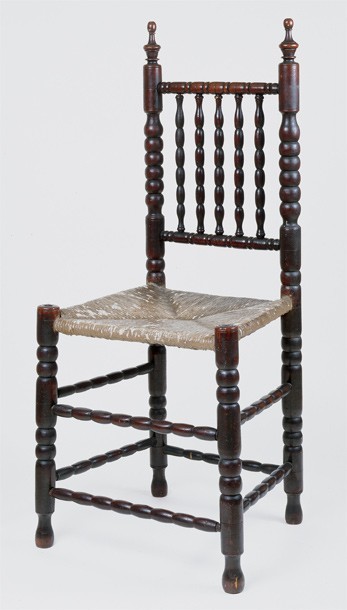
Side chair, New York, 1660-1720. Cherry with unidentified secondary wood. H. 42", W. 18", D. 13 1/2". (Private collection; photo, Helga Studio.)
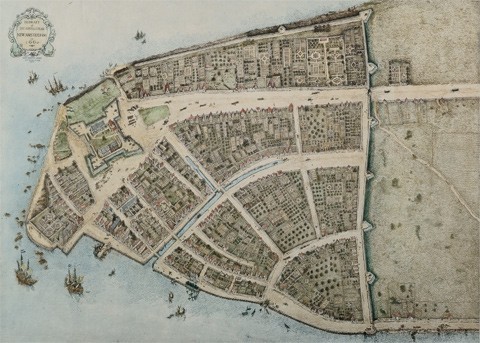
I. N. Phelps Stokes, Redraft of the Castello Plan of New Amsterdam in 1660, New York, 1916. Color gravure on paper. 14 3/8" x 19 1/4". (Courtesy, J. Clarence Davies Collection, Museum of the City of New York.)

Detail of the map illustrated in fig. 2, showing the residences of (a) Lourens Andrieszen van Boskerk, (b) Frederick Arentszen Blom, and (c) David Wessels.
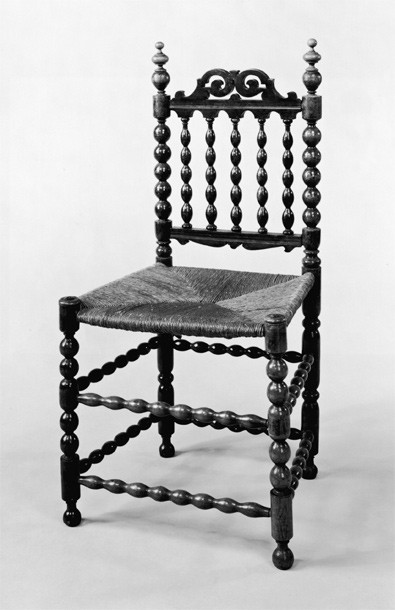
Side chair, northern Netherlands, 1650-1700. Walnut with unidentified secondary wood. H. 40 1/8", W. 18 1/8", D. 15 3/4". (Courtesy, Rijksmuseum.)
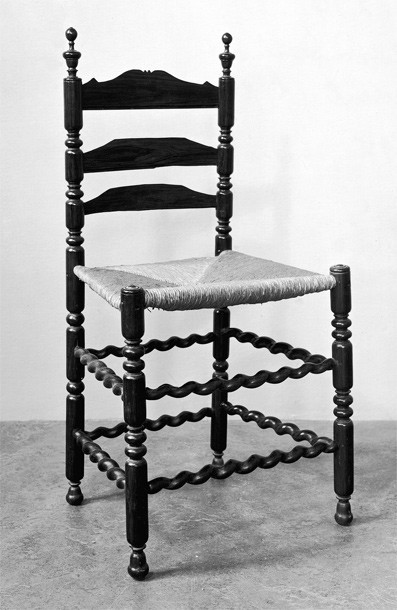
Side chair, northern Netherlands, ca. 1700. Rosewood and walnut with unidentified secondary wood. H. 37 1/2", W. 18 1/8", D. 14 3/4". (Courtesy, Rijksmuseum.)
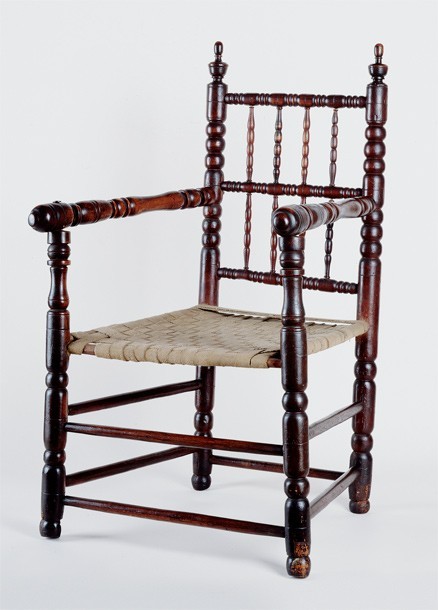
Armchair, New York, 1660-1720. Maple with unidentified secondary wood. H. 40", W. 23", D. 19". (Courtesy, Morristown National Park, National Park Service, U.S. Department of the Interior: photo, Gavin Ashworth.) Several of the vertical spindles and stretchers are replaced.
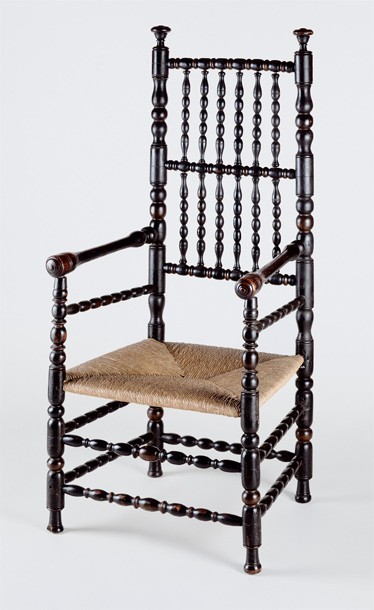
Armchair, New York, 1660-1720. Maple, cherry, and ash with unidentified secondary wood. H. 50 3/8", W. 23 1/4", D. 18 3/4". (Courtesy, Albany Institute of History and Art, Rockwell Fund; photo, Gavin Ashworth.) This chair reputedly descended in the Hendrickson family of Flatbush. With two tiers of back spindles and unusually complex post turnings, this chair is a superb example of the stoelendraaier's art. One arm and several spindles are replaced.

Detail of the left arm and front post of the armchair illustrated in fig. 6. (Courtesy, Morristown National Park, National Park Service, U.S. Department of the Interior: photo, Gavin Ashworth.)

Armchair, probably southeast Virginia, 1670-1720. Cherry with unidentified secondary wood. H. 41 3/4", W. 23 1/2", D. 23 1/2". (Collection of the Museum of Early Southern Decorative Arts, Old Salem Museum & Gardens.)
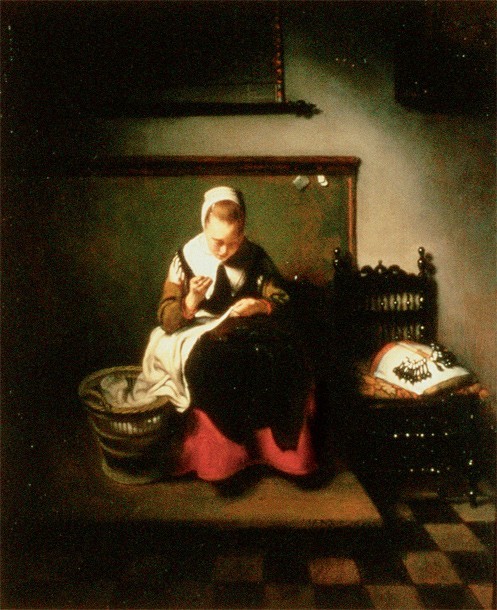
Nicolaes Maes, A Young Woman Sewing, 1655. Oil on panel. 21 3/8" x 17 1/2". (Courtesy, Guildhall Art Gallery, Corporation of London.)

Hendrik van der Burch, The Game of Cards, 1660. Oil on canvas. 30 1/2" x 26 1/2". (Courtesy, Detroit Institute of Arts.)

Detail showing the kitchen of a doll house, Netherlands, 1674-1682. (Courtesy, Central Museum, Utrecht.)

Side chairs, Netherlands, 1674-1682. Walnut with unidentified secondary wood. H. 4 1/3"; width and depth not recorded. (Courtesy, Central Museum, Utrecht.)

Detail of the right rear post and spindles of the chair illustrated in fig. 39. (Photo, Gavin Ashworth.)
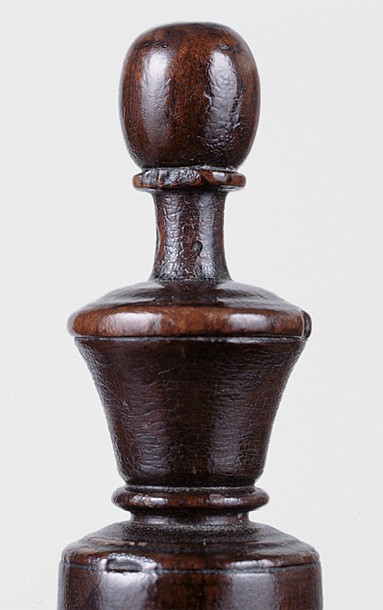
Detail of the right finial of the chair illustrated in fig. 39. (Photo, Gavin Ashworth.)
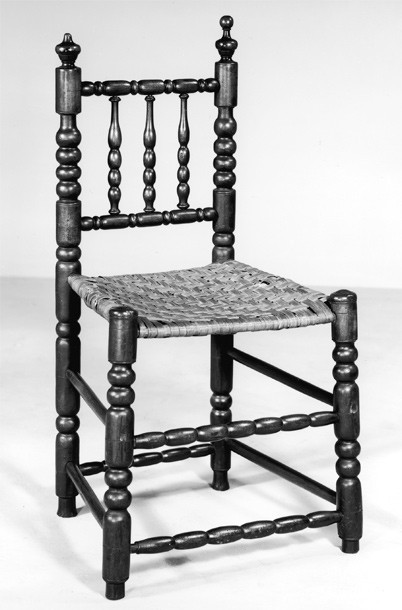
Side chair, New York, 1660-1720. Walnut with hickory. H. 30 11/16 ", W. 16 1/2", D. 13 3/8". (Courtesy, Mabel Brady Garvan Collection, Yale University Art Gallery.)
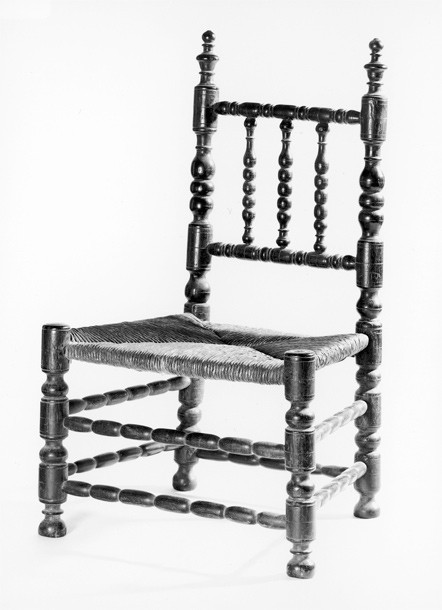
Side chair, New York, 1660-1720. Ebony with red oak. H. 26", W. 15 1/2", D. 14 1/2". (Courtesy, Winterthur Library: Decorative Arts Photographic Collection.)

Detail of a photograph of an exhibit at the bicentennial display, Albany, New York, 1886. (Courtesy, McKinney Library, Albany Institute of History and Art.)
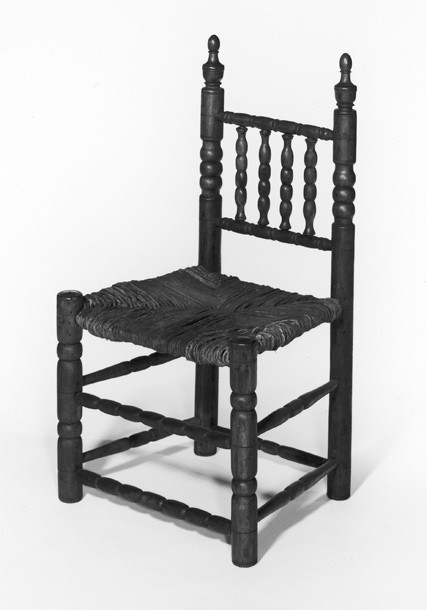
Side chair, New York, 1660-1720. Cherry with white oak. H. 32 3/8", W. 17", D. 15 1/2". (Courtesy, New York State Museum, gift of the Wunsch Americana Foundation.) The mate to this chair is illustrated in fig. 43.

Side chair, New York, 1680-1711. Cherry. H. 37", W. 19", D. 15 1/4". (Private collection; photo, Gavin Ashworth.)

Detail of the weathervane on the Dutch Reformed Church built in Sleepy Hollow, New York, in 1685. Unidentified metals. (Courtesy, Tarrytown Dutch Reform Church; photo, Gavin Ashworth.) This weathervane is a copy based on the original, which still survives in the church. Oral tradition maintains that the weathervane was presented to the church upon its completion.

Armchair, New York, 1675-1725. Maple with unidentified secondary wood. H. 36 1/4", W. 22 3/8", D. 24". (Courtesy, Brooklyn Museum of Art.)
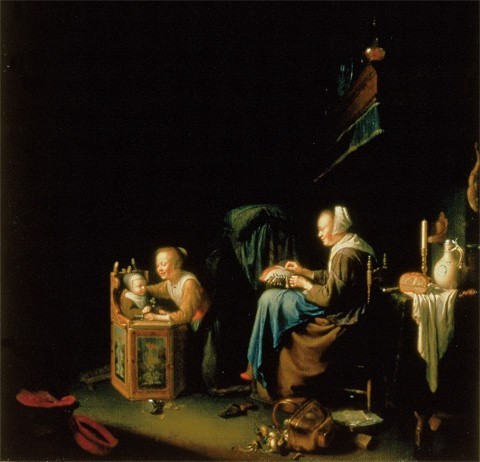
Detail of Pieter Cornelis van Slingelandt, Woman Making Lace with Two Children, Netherlands, ca. 1679. Oil on panel. 18 5/8" x 15 1/2". (Courtesy, Guildhall Art Gallery, Corporation of London.)
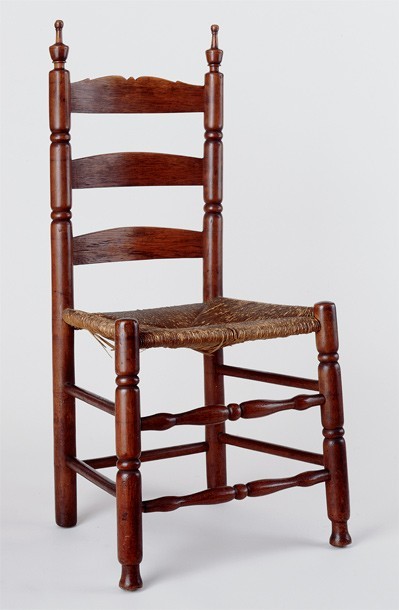
Side chair, New York or northern New Jersey, 1730-1790. Maple with unidentified secondary wood. H. 38 3/8", W. 18", D. 16". (Private collection; photo, Gavin Ashworth.)
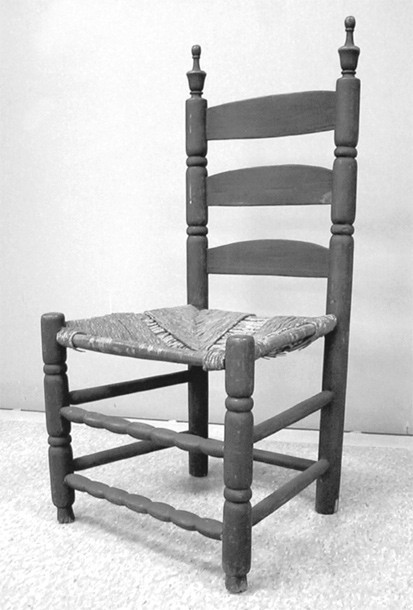
Side chair, New York or northern New Jersey, 1730-1790. Maple with unidentified secondary wood. H. 36 3/4", W. 19 1/8", D. 16". (Courtesy, Staten Island Historical Society.)

Side chair, probably Guilford-Saybrook area of Connecticut, 1680-1710. Maple and ash. H. 30 1/2", W. 17 1/4", D. 14". (Courtesy, Mabel Brady Garvan Collection, Yale University Art Gallery. )
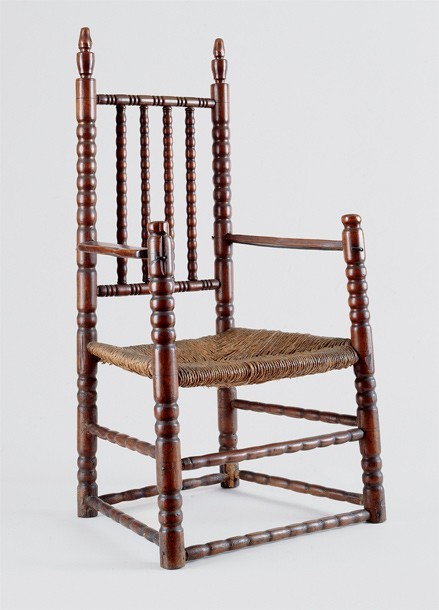
Armchair, New York, 1670-1720. Maple with unidentified secondary wood. H. 40 3/4", W. 21 3/8", D. 15 5/8". (Courtesy, Society for the Preservation of Long Island Antiquities.)
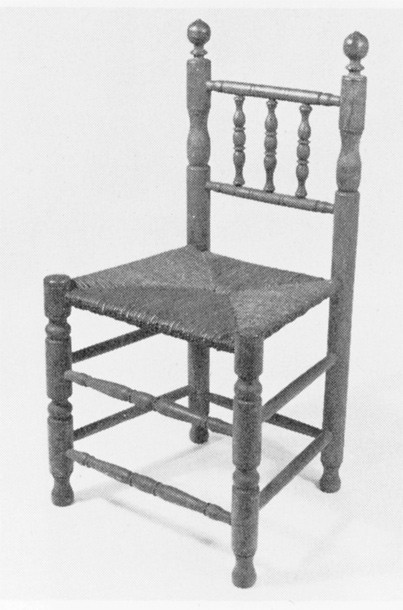
Side chair, New York, 1680-1730. Maple with unidentified secondary wood. Dimensions not recorded. (Courtesy, Sotheby's.)
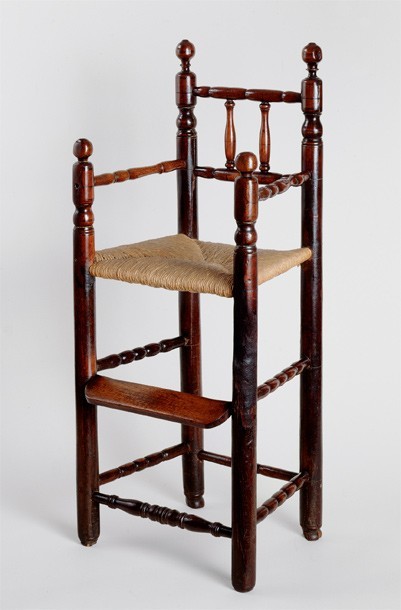
High chair, New York, 1680-1730. Maple with unidentified secondary wood. H. 35 1/2", W. 14 3/4", D. 13 1/2". (Courtesy, Albany Institute of History and Art; photo, Gavin Ashworth.) The chair is branded "RS" on a back leg. The footrest is a modern replacement.
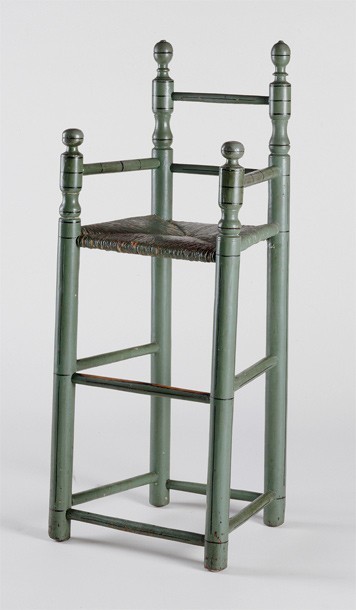
High chair, New York, 1680-1730. UnidentiWed woods; modern green paint. H. 37", W. 23", D. 12 1/2". (Courtesy, Albany Institute of History and Art; photo, Gavin Ashworth.) The back rails, stretchers, and arms may be replacements.
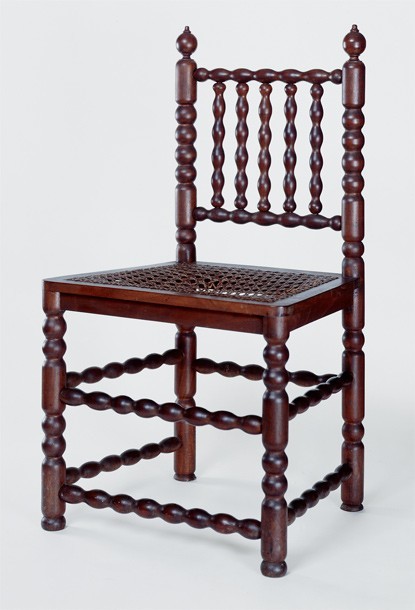
Side chair, New York, 1680-1730. Walnut with unidentified secondary wood. Dimensions not recorded. (Courtesy, Issac Royall House Museum.) The seat and seat rails are replaced.
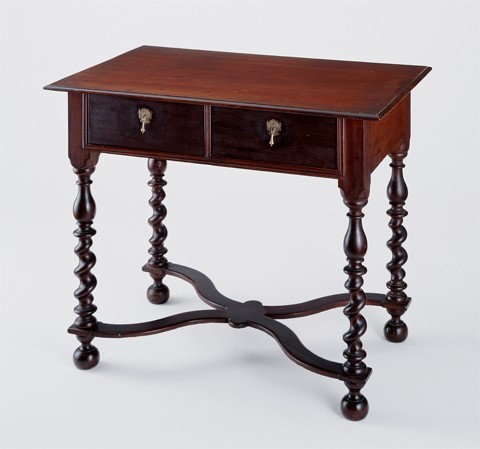
Dressing table, New York, 1680-1710. Mahogany with tulip poplar. H. 33 3/4", W. 28 1/4", D. 22 3/4". (Private collection; photo, Gavin Ashworth.)
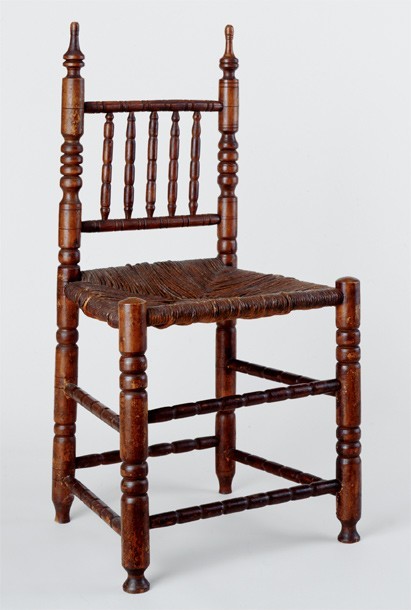
Side chair, New York, 1700-1740. Maple. H. 36 1/2", W. 18 3/4", D. 15". (Private collection; photo, Gavin Ashworth.)

Side chair, New York, 1695-1730. Maple. H. 44 3/4", W. 19 3/4", D. 16". (Courtesy, Albany Institute of History and Art; photo, Gavin Ashworth.)
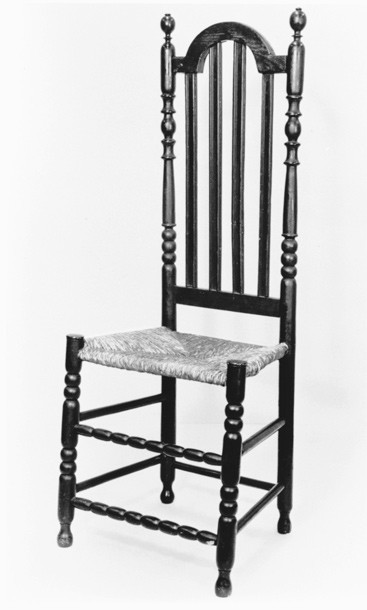
Side chair, New York, 1695-1730. Maple. H. 48", W. 18 3/8", D. 13 1/2". (Courtesy, Bergen County Historical Society.)
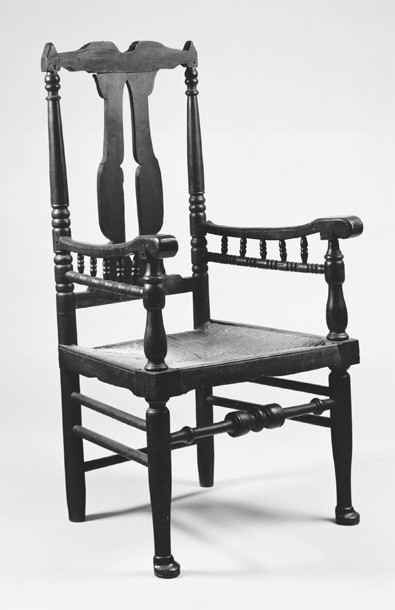
Armchair, New York, 1750-1780. Cherry. H. 47 1/2", W. 26", D. 21 1/2". (Courtesy, Metropolitan Museum of Art, gift of the Wunsch Americana Foundation.)
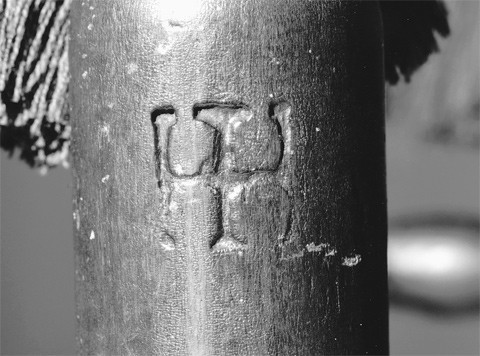
Detail of the "HH" brand on the side chair illustrated in fig. 38.
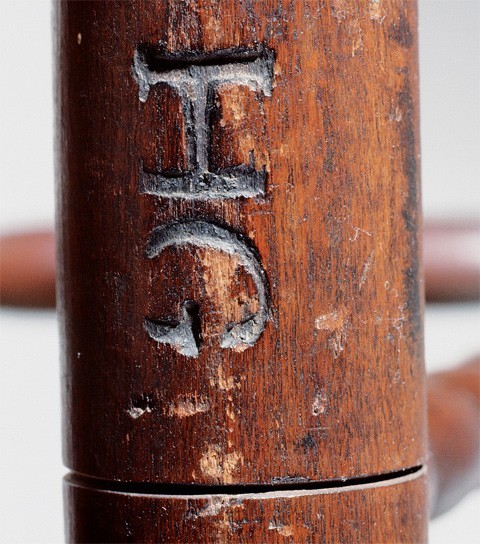
Detail of the "HG" brand on the side chair illustrated in fig. 41. (Photo, Gavin Ashworth.)
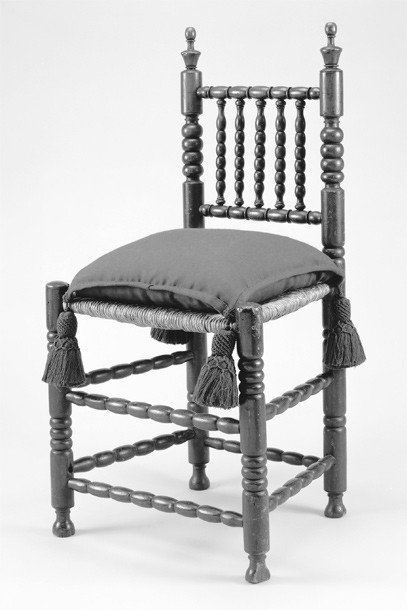
Side chair, New York, 1660-1720. Cherry with ash. H. 35 7/8", W. 18 1/2", D. 15". (Courtesy, Bayou Bend Collection, Museum of Fine Arts, Houston, museum purchase with funds from the Houston Junior Woman's Club.)
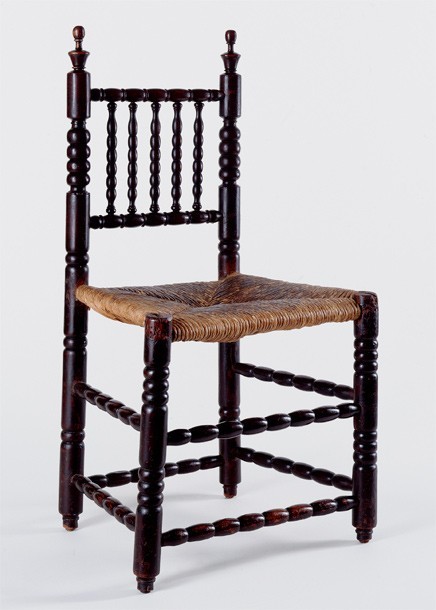
Side chair, New York, 1660-1720. Cherry with ash. H. 34 7/8", W. 18 1/2", D. 15". (Courtesy, Historic Hudson Valley; photo, Gavin Ashworth.)
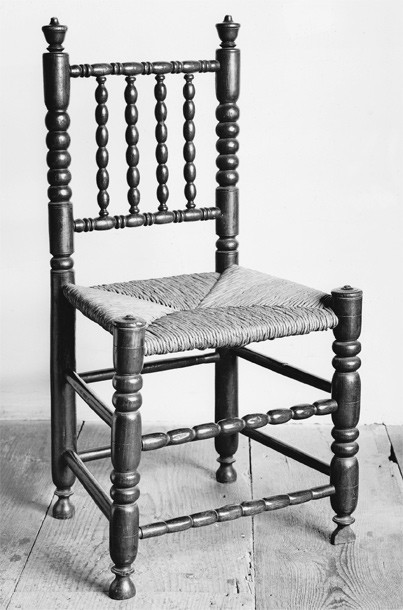
Side chair, New York, 1660-1720. Red mulberry. H. 35 1/2", W. 17", D. 14 3/4". (Courtesy, American Museum in Britain.) The finials have lost their pointed tops.
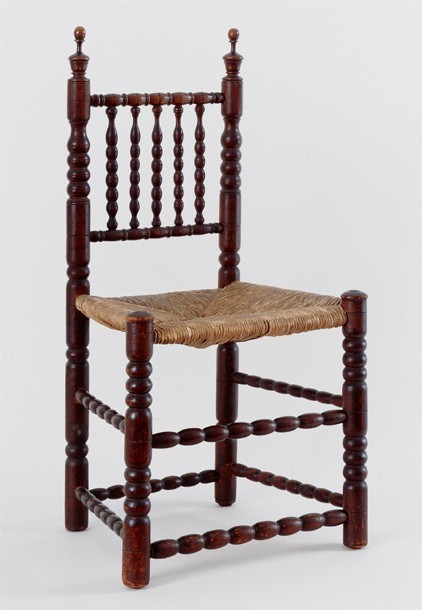
Side chair, New York, 1660-1720. Cherry with unidentified secondary wood. H. 36 1/8", W. 18 3/4", D. 14 1/2". (Courtesy, New Jersey State Museum).

Side chair, New York, 1660-1720. Unidentified woods. H. 37", W. 18 1/2", Depth not recorded. (Anderson Art Galleries, Francis P. Garvan Collection, January 8-10, 1931, lot 107.)

Side chair, New York, 1660-1720. Cherry with white oak. H. 34 7/8", W. 17 3/4", D. 15 1/4". (Courtesy, Winterthur Museum.) The mate to this chair is illustrated in fig. 18.

Side chair, New York, 1660-1720. Cherry with unidentified secondary wood. H. 37 3/8", W. 18 1/8", Depth not recorded. (Private collection; photo, Gavin Ashworth.)

Side chair, New York, 1660-1720. Cherry with white oak. H. 34 3/8", W. 18 3/4", D. 16 1/8". (Courtesy, Winterthur Museum.)
Objects often illuminate aspects of personal life rarely conveyed in historical documents. The kast, for example, has long been associated with Dutch settlers in early New York. In addition to being eminently useful for the storage of household textiles, these ubiquitous cupboard forms were a source of pride for their makers and symbols of wealth, order, and abundance for their owners. A large group of early turned chairs (fig. 1) provides an alternative and possibly better perspective on New York's pluralistic society. Like early Boston and New York "leather chairs," these ornate seating forms show how artisans and consumers "engaged with their mental and material worlds.[1]
In the Netherlands, spindle-back chairs were typically made by stoelendraaiers, a specific class of artisan that specialized in the production of turned seating. David Wessels (1654-1678) is the only New York artisan identified as a stoelendraaier; however, twelve other drayers, "turners," and "chairmakers" worked there in the seventeenth century: Thomas Paulus (1669), Lourens Andrieszen van Boskerk (Buskirk) (1636-1694), Frederick Arentszen (Blom) (1654-1686), Arent Frederickszen Blom (1657-1709), Jacob Blom (1676-1731), Jacob Smit (1686), William Bogaert (1690-1703), Johannes Byvanck (1677-1727), Johannes Tiebout (1689-1728), Rutgert Waldron (1677-1720), Jan Poppen (1675-1689), and Albert Van Ekelen (1684).[2]
The earliest turners who arrived in New York came from different areas of northern Europe. David Wessels emigrated from Esens, East Friesland, Holland, an area adjoining western Germany; Lourens Andrieszen van Boskerk came from Holstein, Denmark; and Frederick Arentszen Blom was a native of Swarte Sluis, Overyssel, Holland. Frederick, however, did not immigrate directly from Swarte Sluis. When Lourens Andrieszen van Boskerk traveled to Amsterdam in 1654, he found Blom working for a turner and convinced him to immigrate to New York and serve a three-year apprenticeship. On July 23, 1656, Blom "without either words or reason...ran away from" van Boskerk and married Grietie Pieters. Although the master sued his apprentice for breach of contract, nothing came of the matter. During the ensuing years, van Boskerk, Blom, and Wessels lived near each other and interacted socially and professionally (figs. 2, 3).[3]
On March 24, 1662, Blom and Wessels complained that "some people come from out of the City asking for work or to make chair matting and are allowed to earn the wages." The petitioners noted that they were "Burghers" who paid city taxes and requested that the practice "be forbidden, for it prevents them [from supporting]...themselves and their families." Artisans often joined forces to oppose competition and secure contracts for large public projects. On April 27, 1702, the Council of the Colony of New York recorded payments to Frederick Blom's son Jacob and turner Rutgert Waldron for work done on the fort.[4]
The Bloms are the only documented family of seventeenth-century New York turners. As historian Joyce Goodfriend has noted, family and ethnicity were essential factors in determining occupation in that colony. Kinship allowed for the direct transmission and propagation of design and craftsmanship. Fathers often trained sons and left them tools and other property related to their trade. On March 23, 1711/12, turner Johannes Byvanck left his eldest son Evert all his tools and "wearing apparel," a great "Bilested chest," and £5. Evert may also have inherited an equally valuable asset--the good will of his father's patrons.[5]
Religion was another vehicle for the transmission of design and patronage. David Wessels and Lourens Andrieszen van Boskerk were Lutherans and often signed ecclesiastical documents together. Like many seventeenth- and eighteenth-century artisans, they probably met potential clients and made business contacts in their respective churches.[6]
Netherlandish Sources
The urban Dutch chairs illustrated in figures 4 and 5 are cognates for the seating produced by early New York turners such as Wessels and van Boskerk. Details shared by the European and American forms include low backs, tall urn finials, elliptical spindle and stretcher turnings, posts with ball and/or baluster elements, front posts with turned tops, and four turned feet. Rail and spindle backs like those on many Dutch chairs (fig. 4) do not occur on New York seating, but are relatively common in other areas of Netherlandish settlement.[7]
The armchairs illustrated in figures 6 and 7 may represent the work of first generation New York stoelendraaiers. Both have massive arms that extend beyond the front posts (fig. 8) and other turned components that are larger and more robust than those on related New York side chairs (see fig. 1). Furniture historians Robert Leath and John Bivins have documented the production of similar armchairs (fig. 9) in northeast North Carolina and southeast Virginia--an area strongly influenced by Dutch and French styles during the last half of the seventeenth century.[8]
New York inventories provide little information regarding the design or use of early seating forms. During the seventeenth and early eighteenth centuries, appraisers typically referred to chairs by their woods, paint color, or upholstery material. Turned forms were usually described as having "matted," "flagged," or "rushed" seats. The 1686 estate inventory of former New York City mayor Cornelius Steenwyck lists rush-seated chairs in the "kitchen chamber." Contemporary records also document their use in "kitchen chambers," "great chambers," and bedrooms.[9]
Seventeenth-century Netherlandish genre paintings frequently depict turned chairs in domestic settings. Nicolaes Maes' A Young Woman Sewing (fig. 10) shows a chair similar to the one illustrated in figure 4 adjacent to a soldertien, a low dias used to reduce drafts, whereas Hendrik van der Burch's The Game of Cards (fig. 11) portrays a mother and child seated on related spindle-back forms. Although most Dutch genre paintings were staged, many of the objects depicted in them were present in wealthy households. The kitchen of Petronella de la Court's (1674-1707) doll house (fig. 12) has a set of six miniature spindle-back side chairs (fig. 13) similar to those in the aforementioned paintings. With their turned back rails and urn finials, these miniature forms are the closest parallels to the New York chairs illustrated here.[10]
At least twenty-five New York chairs with related turnings are known. Although these objects clearly represent the work of several different shops, all have spindles with ring and baluster turnings at the top and bottom and elliptical elements in the middle (fig. 14). Some chairs have similar turnings on the rear posts (see fig. 1), but most have abbreviated sequences to compensate for differences in space and scale (fig. 16). Tall urn-shaped finials are another distinctive feature of chairs in this group. Similar finials also appear on many later slat-back chairs found in the vicinity of Bergen County, New Jersey, which suggests that at least one New York turner may have moved there during the eighteenth century.[11]
Most of the chairs in the New Netherland group are made of cherry, a wood rarely found in seventeenth-century American seating furniture. Cherry grew throughout the middle Atlantic region, and joiners from a variety of cultural traditions used it for case and table forms. Furniture historian Peter Kenny has shown that New York Dutch artisans used cherry for kasten, draw-bar tables, and gateleg tables. This tight grained wood was stable, easy to turn, and readily accepted stains and finishes, which undoubtedly appealed to stoelendraaiers desiring to simulate the exotic woods often found on urban Dutch chairs. The side chair shown in figure 1 has its original mahoganized surface, as do several contemporary New York draw-bar tables. Several chairs in the group probably had similar finishes or surfaces intended to resemble ebony.[12]
Other primary woods used in the construction of New Netherland turned chairs include walnut, maple, mulberry, and ebony. The example shown in figure 15 was thought to have European walnut components, but the microscopic wood identification may have been incorrect. Calcium oxalate crystals, which are present in the axial parenchyma of American black walnut but absent in European walnut, are not always visible in small samples. More importantly, the chair has stretchers made of hickory, an indigenous American wood that does not appear to have been exported to Britain or Europe. Court records indicate that early New York stoelendraaiers used black walnut for chairs and other turned forms. On May 1, 1666, Sieur Nicolaes Varlet sued Frederick Arentszen Blom for failing to make a black walnut spinning wheel. Seven years later Philip Johns complained that he had given Frederick Arentszen Blom "a parcel of Black walnunt...for the makeing of...Chayres, which...the defendant sold...to another person."[13]
If the chair shown in figure 15 has European walnut components, that does not disprove its attribution. The Dutch were at the forefront of the international lumber trade, and exotic species such as ebony were available in New Amsterdam by 1644. Netherlandish chair makers often used ebony in conjunction with lighter woods such as walnut and rosewood, but they occasionally made seating entirely of a single exotic. A New York child's chair follows the latter practice in having ebony posts, rails, spindles, and stretchers (fig. 16).[14]
The cost of New York chairs similar to those illustrated here is diYcult to determine because period references are scarce, and prices undoubtedly varied depending on the type of wood and complexity of the turnings. On November 11, 1657, Frederick Arentszen Blom purchased a house lot on Market Street in New Amsterdam from Teuis Tomassen van Narrden, who agreed to take three chairs valued at four guilders each as "part of the price." Two and a half years later, Blom appeared before the New Amsterdam Court arguing that Jan Janzen owed him eight guilders for two chairs. Janzen subsequently acknowledged the debt and offered "payment in plank." Blom's price of four guilders per chair appears moderate given the fact that fellow turners Lourens Andrieszen van Boskerk and David Wessels paid taxes of fifteen guilders and ten guilders respectively in 1655. Blom may also have produced case furniture. On September 27, 1661, Jan Jurriaansen Becker complained that his wife bought a chest of drawers from Blom for twenty-five guilders, whereas the latter asserted that he charged twenty-two guilders. Although it is impossible to determine if Blom made the chest, he probably turned balusters, spindles, and other ornaments for local joiners and carpenters.[15]
The Culture, Context, and Dating of New Netherland Spindle-Back Chairs
Although the English seized control of New Netherland in 1664, Dutch culture and influence persisted for over 150 years. The origins of this dominion can be traced to the Dutch West India Company's establishment of large land grants, or patroonships, in 1629. In exchange for their allegiance, the British Crown allowed many patroons to retain their vast estates under the British manorial system. This preserved much of the old social hierarchy, and ensured that the landowners and their progeny would retain considerable wealth, prestige, and political power.[16]
Late eighteenth-century kasten and jambless fireplaces are but a few of the many artifacts documenting the persistence of Dutch culture in the Hudson River Valley. Netherlandish traditions survived longer and more intact in rural areas, but even the wealthiest Dutch families who maintained residences in New York City had a reverence and respect for their origins. Furniture historian Lauren Bresnan has shown that their urban houses typically had English and Anglo-American furnishings, whereas their country residences often had family heirlooms as well as objects made by New York Dutch artisans. These patterns of production, consumption, and use have created confusion regarding the origin, date, and possible makers of New York spindle-back chairs.[17]
In the Netherlands, spindle-back chairs like those shown in the Maes and van der Burch paintings (figs. 10, 11) and the doll house of Petronella de la Court (fig. 12) were luxury furnishings typically commissioned by the wealthy and middle class. Immigrant stoelendraaiers probably discovered that their specialized craft could not sustain them or their family in the New World. To subsist, they had to expand their production. Frederick Arentszen Blom, for example, sold William Laurence "blocks and other turners worke" valued at fl. 1100 for the ship James in 1671. Stoelendraaiers who focused on the manufacture of turned seating needed to reside in densely populated areas where their work would be in higher demand. Bergen County, which some scholars considered the place of origin for the chairs discussed here, was an agricultural area settled by Dutch farmers who were unable to acquire land in Manhattan and western Long Island. During the seventeenth and early eighteenth centuries, this region was sparsely populated and unable to sustain a school of turning as large as that represented by this group of chairs. The only early drayer documented in northern New Jersey is Lourens Andrieszen van Boskerk, who moved from New Amsterdam to Minkakwa for religious reasons by 1664.[18]
Although most of the spindle-back chairs in the group probably represent the work of New York City stoelendraaiers, some may have been made in Fort Orange (Albany), which grew from a trading post to a town of moderate size by the end of the seventeenth century. A side chair included in an exhibition of local "relics" at the 1886 Albany Bicentennial supports this hypothesis (figs. 17, 18). Alternatively, chairs like this example may have been made in New York and shipped up the Hudson River. On August 20, 1658, Frederick Arentszen Blom reported that his wife "had gone to Fort Orange with a parcel of chairs to procure beavers for them."[19]
Four of the chairs in the group have credible histories. The example illustrated in figure 19 descended in the family of Johannes De Peyster (1666-1711) of New York City, and the armchair shown in figure 7descended in the family of Daniel Hendrickson, Sr. (d. 1728) who lived in Flatbush, Brooklyn. These historical associations and the close relationship between the earliest New York chairs and their European cognates suggest that most of the examples date from the late seventeenth and early eighteenth centuries. The finials on several of these chairs are similar to that of a weathervane (fig. 20) on the Sleepy Hollow Dutch Reformed Church which was built about 1685.[20]
Degraded versions of these finials appear on chairs made in New York and New Jersey as late as the twentieth century. The longevity and geographic distribution of this design is directly related to the settlement and cultural history of New York. After the English conquest, Dutch immigration dwindled significantly. By 1695, only twelve percent of New York's population consisted of first-generation Dutch emigrés. Time, distance, and isolation from Netherlandish design sources had a profound influence on regional furniture styles. During the late seventeenth century, many artisans and consumers of Dutch descent began embracing English fashions and cultural traditions. As noted, Dutch material culture did not disappear. Just as Netherlandish details appear on New York silver from the eighteenth century, northern European stylistic and structural features are common on furniture made by second-, third-, and fourth-generation turners, joiners, and cabinetmakers working in the Hudson River Valley. Spindle-back chairs were eventually displaced by cheaper and less overtly continental slat-back forms, but certain turning sequences, such as the tall urn-shaped finial, remained fashionable from the seventeenth century to the twentieth century.[21]
New York stoelendraaiers undoubtedly produced both slat-back and spindle-back forms. The slat-back armchair illustrated in figure 21 has large urn finials, stretchers with elliptical turnings, and front posts with bold baluster, ring, and ball-shaped elements--details associated with the earliest spindle-back forms. Similarly, its shaped upper slat resembles those on surviving Dutch chairs (see fig. 5) as well as those depicted in seventeenth-century genre paintings (fig. 22). Although one later slat-back chair shares this detail (fig. 23), most examples made between 1730 and 1800 have simple arched slats and components made of thinner stock (fig. 24). Not surprisingly, the turnings on related eighteenth- and early nineteenth-century slat-back and spindle-back chairs from New York and northern New Jersey tend to be thinner and less detailed than corresponding elements on earlier examples.
Presumably, British influences began filtering into New York chairmaking traditions during the late seventeenth century. None of the earliest examples have rail-and-spindle backs, like the seating depicted in the Maes and van der Burch paintings (figs. 6, 7). All of the back components of the New York chairs are turned, as are those on most contemporary English and New England examples (fig. 25). Although chairs made by stoelendraaiers in Holland and areas of Dutch influence often have fully turned backs, the absence of New York examples with rail-and-spindle construction may reflect a concession to British taste. An armchair (fig. 26) with a recovery history in Seatucket, Long Island, points out the difficulty of identifying specific Dutch and English features. Its finials and back spindles are modified versions of those on the earliest New York turned chairs, whereas its flat arms and pommels have precedents in Netherlandish, English, and New England work. A large group of seventeenth-and early eighteenth-century Dutch and New York slat-back armchairs have similar arms and pommels, as does a smaller group of contemporary turned great chairs attributed to the Boston-Charlestown area of Massachusetts.[22]
Several seating forms made in and around New York share details with the earliest spindle-back chairs, but also have features associated with other chairmaking traditions. The side chair illustrated in figure 27 has turned feet, front posts with compressed balusters, and spindles with elliptical elements in the center and balusters at the top and bottom. All of these features occur, albeit in slightly different form, on the more overtly Netherlandish forms exemplified by the chair shown in figure 1. The elongated balusters of the rear posts and peaked ball finials represent departures from the primaryNetherlandish tradition, but all of these features have precedents in New England work. The finials and balusters of the rear posts are similar to those on chairs (see fig. 25) attributed to the Guilford-Saybrook area of Connecticut, which is just up the Long Island Sound from New York City. Related turnings are also on two child's chairs (figs. 28, 29), one of which is branded "RS" (fig. 28) for Robert Sanders (1705-1765) of Albany. Although some scholars have suggested that Sanders may have purchased the chair for his first child Maria (1749-1830), the style and workmanship of this object point to an earlier owner. It is much more likely that Robert's parents, Barent (1678-1757) and Maria (Wendell) (1677-1734), commissioned the chair. The other example descended in the Ten Eyck family of Albany. It appears to have replaced arms, stretchers, and back spindles and rails. Presumably, the original components were similar to those of the Sanders example.[23]
An unusual walnut side chair (fig. 30) with finials related to those on the preceding seating forms supports the idea that both high chairs (figs. 28, 29) were made in New York City during the early 1700s and subsequently transported up the Hudson River. With its ball-turned front and back posts and elliptically turned spindles and stretchers, this side chair clearly emanates from an urban Dutch tradition. Its proportions and turning sequences are similar to those on the core group of New York chairs (see fig. 1), and, like those forms, it would have complemented the high chests, dressing tables (fig. 31), and draw-bar tables found in upper class homes.[24]
Like the distinctive urn finial, some of the furniture forms introduced by northern Europen stoelendraaiers persisted in the Hudson River Valley for decades. This was particularly true of rural Dutch communities, which tended to be more conservative and less influenced by new styles than their urban counterparts. The side chair illustrated in figure 32 may be the product of a rural turner. It is slightly later than most of the related spindle-back examples, and its turnings are much less refined in form and execution.
Regardless of their location or cultural background, stoelendraaiers had to accommodate their patrons' tastes. Urban turners also had to compete with imported caned, leather, and banister-back chairs from Britain and Boston. During the 1720s, the scions of first-generation stoelendraaiers began producing relatively inexpensive seating (figs. 33, 34) that combined British and Anglo-American features--molded arched crests and multiple banister backs--with details found on early Netherlandish chairs--stretchers with elliptical elements and legs with compressed balls and turned caps and feet. The armchair shown in figure 35 is one of the most unusual cross-cultural hybrids. Its miniature spindles and rear post turnings clearly emanate from a New York turning tradition, whereas its banister back, crest, and pad feet reflect late baroque influences from England and New England.[25]
Markings, Sets, and Makers
As with Robert Sanders' high chair (fig. 28), several early New York spindle-back chairs are branded. Of the five known marks, the "HH" (fig. 36) and "RS" brands are conjoined in the typical Dutch manner, whereas the "HG" (fig. 37), "HR," and "A" are not. Four chairs with identical turnings are branded "HH" (figs. 38, 39) and are clearly from the same set. The "A" brand is on a red mulberry chair published in Wallace Nutting's Furniture Treasury (1928) (fig. 40), and the "HG" brand is on a slightly larger pair made of cherry (fig. 41). A chair nearly identical to the ones marked "HG" was in the collection of Francis P. Garvan in 1931, but it was branded "HR" (fig. 42). The presence of two different brands on chairs that appear to be from the same shop suggests that the marks refer to owners rather than makers. Unmarked chairs with closely related turnings (figs. 1, 18, 43, 44) support this conclusion. The chair illustrated in figure 45, for example, has feet, finials, and leg turnings similar to those on the "HH" set.[26]
Documentary evidence suggests that Netherlandish spindle-back chairs were being made in New York by first-generation stoelendraaiers as early as the 1650s. Although most of the chairs illustrated here probably date from the last third of the seventeenth century, they are representative of the earliest turned seating produced in New Netherland. Journeymen and apprentices who learned their trade from first-generation stoelendraaiers continued to produce similar forms until changing tastes and competition from British and New England imports ultimately forced them to modify their styles. The persistence of this chairmaking tradition is a testament to the strength and vitality of Dutch culture and its adaptability to the changing political, social, and economic landscape of colonial New York.
ACKNOWLEDGMENTS
For assistance with this article, the author thanks Gavin Ashworth, Roderic Blackburn, Elaine Clark, Meredith Cohen, Jet Pijzel-Dommisse, Judith Elsdon, Susan Finkel, Lori Fisher, Maxine Friedman, Mr. and Mrs. Dudley Godfrey, Jr., Sue Glyson, Mr. and Mrs. Arthur Goldberg, Joyce Goodfriend, Mr. and Mrs. Norman Gronning, Mr. and Mrs. Donald Hare, Kate Johnson, Neil Kamil, Peter Kenny, Sandra Markham, Joni Rowe, Frances Safford, John Shear, Kevin Stayton, Ruth Piwonka, Kevin Wright, and Mr. and Mrs. Fred Vogel. I am especially grateful to Shelley Farmer for her continued support and encouragement.
Wallace Nutting was the first furniture historian to illustrate New Netherland turned chairs (Wallace Nutting, Furniture Treasury, 3 vols. [1928; reprint, New York: Macmillan, 1966], 2: nos. 2085-86). More recent attempts to interpret these chairs are John T. Kirk, "Sources of Some American Regional Furniture, Part I,"Antiques 88, no. 6 (December 1965): 798; John T. Kirk, American Furniture and the British Tradition to 1830 (New York: Alfred A. Knopf, 1982), p. 235; and Benno M. Forman, American Seating Furniture: 1630-1730 (New York: W. W. Norton, 1988), pp. 114-19. Peter Kenny, Frances Safford, and Gilbert T. Vincent, American Kasten: The Dutch-Style Cupboard of New York and New Jersey, 1650-1800 (New York: Metropolitan Museum of Art, 1991), pp. 1-10. Neil D. Kamil, "Of American Kasten and the Mythology of Pure Dutchness," in American Furniture, edited by Luke Beckerdite (Hanover, N. H.: University Press of New England for the Chipstone Foundation, 1994), pp. 275-82. Neil D. Kamil, "Hidden in Plain Sight: Disappearance and Material Life in Colonial New York," in American Furniture, edited by Luke Beckerdite (Hanover, N. H.: University Press of New England for the Chipstone Foundation, 1995), pp. 191-249.
Stoel means chair and draaier means turner. The 1749 edition of Sewall's Dutch Dictionary lists draaijer and wieldraaijer for "turner." On July 17, 1664, David Wessels requested that the Orphanmaster Council allow Class Gerritsen to be his apprentice for five years to learn the trade of "stoeldraijen" (chair turning) and "laden maachen" (drawer making), The Minutes of the Orphanmasters of New Amsterdam, 1663-1668, edited by Ken Stryker Rodda and Kenneth Scott [Baltimore, Md.: Genealogical Publishing Co., 1976], p. 12). Year Book of the Holland Society of New York, 1900 (New York: Knickerbocker Press, 1900), p. 126. Thomas Paulus is described as a "drayer" in a record dated September 16, 1669 (A. J. F. Van Laer, Minutes of the Court of Albany, Rensselaerswyck and Schenectady, Vol I: 1668-1673 [Albany, N. Y.: University of the State of New York, 1926], pp. 99-100); however, he may have been a baker (A. J. F. Van Laer, Early Records of the City and County of Albany and the Colony of Rensslaerswyck, 4 vols. [Albany, N. Y.: University of the State of New York, 1919], 3: 143). Berthold Fernow, The Records of New Amsterdam from 1653-1674, 7 vols. (1897; reprint, Baltimore, Md.: Genealogical Publishing Co., 1976), 1: 371; 7: 151; and "The Burgers of New Amsterdamn and the Freemen of New York 1675-1866" in Collections for the New-York Historical Society for year 1885 (New York: By the Society, 1886), pp. 20, 63, 70, 71, 72, 73 list the following artisans and their trades: Lourens Andrieszen van Boskerk, "drayer," October 11, 1655; David Wessels, "chairmaker," April 13, 1657; Frederick Arentszen Blom, "drayer," February 11, 1658; Jacob Blom, "turner," August 9, 1698; Arent Blom, "blockmaker," September 6, 1698; William Bogaert, "turner," September 6, 1698; Johannes Byvanck, "turner," February 2, 1699; Johannes Tiebout, "turner," February 2, 1699; and Rutgert Waldron, "turner," February 3, 1699. Jacob Smit is described as a "turner," in Fernow, The Records of New Amsterdam from 1653-1674, 7: 48; and "New York Wills 1665-1707," in Collections for the New-York Historical Society for year 1892 (New York: By the Society, 1892), p. 95. Turners Jan Poppen and Albert Van Ekelen are listed in Dean Failey, Long Island is My Nation: The Decorative Arts and Craftsmen 1640-1830 (Setauket, N.Y.: Society for the Preservation of Long Island Antiquities, 1976), p. 283. English immigrant Henry Brasier (Brasar) (w. 1648-1689) referred to himself as a turner in his will (Collections for the New-York Historical Society for year 1892, p. 245), but other documents describe him as a carpenter.
Council Minutes, 1652-1654: New York Historical Manuscript Series, translated and edited by Charles Gehring (Baltimore, Md.: Genealogical Publishing Co., 1983), p. 172. Iconography of Manhattan Island, 1498-1909, edited by I. N. P. Stokes, 6 vols. (New York: Robert H. Dodd, 1915-1928), 2: 221. James Riker, Revised History of Harlem: Its Origin and Early Annals (New York: New Harlem Publishing Co., 1904), p. 128. Albert Van Ekelen served an apprenticeship with Flatlands/Flatbush turner Jan Poppen (Failey, Long Island is My Nation, p. 283). Fernow, The Records of New Amsterdam from 1653-1674, 2: 144, 149.
Minutes of the Orphanmasters of New Amsterdam, 1655-1663, translated and edited by Berthold Fernow, 2 vols. (New York: Francis P. Harper, 1902-1907), 2: 132-33. Berthold Fernow, Calendar of Council Minutes, 1668-1783 (1902; reprint, Harrison, N.Y.: Harbor Hill Books, 1987), p. 167.
Joyce D. Goodfriend, Before the Melting Pot: Society and Culture in Colonial New York City, 1664-1730 (Princeton, N. J.: Princeton University Press, 1992), pp. 101-3. "Abstract of Wills, Vol. II, 1709-1723," in Collections for the New-York Historical Society for year 1893 (New York: By the Society, 1893), p. 88. Failey, Long Island is My Nation, p. 283. For more on patronage in New York, see Simon Middleton, "The World Beyond the Workshop: Trading in New York's Artisan Economy, 1690-1740," New York History 81, no. 4 (October 2000): 381-416.
Arnold J. H. van Laer, The Lutheran Church in New York: 1649-1772 (New York: New York Public Library, 1946), pp. 20, 21, 30, 31, 36-40. The Andros Papers: 1674-1676, edited by Peter R. Christoph and Florence A. Christoph (Syracuse, N. Y.: Syracuse University Press, 1989), p. 17. The Lutheran faith was poorly received in New York. Van Boskerk and Wessels frequently wrote home requesting aid.
Chairs with rail-and-spindle backs are common in southeast Virginia and northeast North Carolina, areas strongly influenced by Dutch and French culture. For more on such chairs, see Robert Leath, "Dutch Trade and Its Influence on Seventeenth Century Chesapeake Furniture," in American Furniture, edited by Luke Beckerdite (Hanover, N. H.: University Press of New England for the Chipstone Foundation, 1997), pp. 33-35. John Bivins and Forsyth Alexander, The Regional Arts of the Early South: A Sampling from the Collection of the Museum of Early Southern Decorative Arts (Chapel Hill: University of North Carolina Press for the Museum of Early Southern Decorative Arts, 1991), p. 21, n. 2. Tolletjie chairs from South Africa share numerous details with the New York spindle-back examples illustrated here. Two African chairs made of orangewood and dating ca. 1750 are in the Stellenbosh Museum in South Africa. For more on South African seating, see M. G. Atmore, Cape Furniture (Cape Town, South Africa: Citadel Press, 1965), pp. 61, 62, 91; Michael Baraitster and Anton Obholzer, Cape Country Furniture (Cape Town, South Africa: Struink Publishers, 1982), pp. 21-27, 92, 93; Michael Baraitster and Anton Obholzer, Town Furniture of the Cape (Cape Town, South Africa: Struink Publishers, 1987), p. 62; Richard Beatty, "Cape Dutch Design," Colonial Homes 10 (September-October, 1984): 86; William Fehr, Treasures at the Castle of Good Hope (Cape Town, South Africa: Howard Timmins, 1963), p. 113; and G. E. Pearse, Eighteenth-Century Furniture in South Africa (Pretoria, South Africa: J. L. Van Schaik, 1960), pp. 18, 22.
Leath, "Dutch Trade and Its Influence," pp. 33-35. Bivins and Alexander, The Regional Arts of the Early South, p. 21, no. 2.
For early New York inventories, see Ruth Piwonka, "New York Colonial Inventories: Dutch Interiors as a Measure of Cultural Change," in New World Dutch Studies: Dutch Arts and Culture in Colonial America 1609-1776, edited by Roderic H. Blackburn and Nancy A. Kelly (Albany, N.Y.: Albany Institute of History and Art, 1988), pp. 63-81; and Esther Singleton, Dutch New York (New York: Dodd, Mead & Co., 1909), pp. 81-103. For the Steenwyck inventory, see Peter M. Kenny, "Flat Gates, Draw Bars, Twists, and Urns: New York's Distinctive, Early Baroque Tables with Falling Leaves," in American Furniture, edited by Luke Beckerdite (Hanover, N. H.: University Press of New England for the Chipstone Foundation, 1994), p. 108. The 1711 inventory of Margareta Schuyler lists six stoelen (chairs) in the kitchen (Roderic H. Blackburn and Ruth Piwonka, Remembrance of Patria: Dutch Arts and Culture in America, 1609-1776 [New York: Albany Institute of History and Art, 1988], p. 148).
Shirley Glubok, "The Dolls' House of Petronella de la Court," Antiques 137, no. 2 (February 1990): 489-501. S. Muller Jr. and W. Vogelsang, Holländische Patrizierhäuser (Utrecht, Holland: Verlag Von A. Oosthoek, 1909), pls. 5b, 11.7. Jet van Pizel, a specialist in seventeenth-century doll house furniture, provided this information.
Many slat-back chairs with tall, urn-shaped finials have been found in the Bergen County region of New Jersey. Consequentially, dealers and collectors began referring to these turnings as "Bergen County" finials.
For a New England joined chair made of cherry, see Peter Follansbee, "A Seventeenth-Century Carpenter's Conceit; The Waldo Family Joined Great Chair," in American Furniture, edited by Luke Beckerdite (Hanover, N.H.: University Press of New England for the Chipstone Foundation, 1998), pp. 197-214. Seventeenth-century, southern turned chairs made of cherry are illustrated in Luke Beckerdite, "Religion, Artisanry, and Cultural Identity: The Huguenot Experience in South Carolina, 1680-1725," in American Furniture, edited by Luke Beckerdite (Hanover, N. H.: University Press of New England for the Chipstone Foundation, 1997), pp. 203-4; and Bivins and Alexander, The Regional Arts of the Early South, p. 21, no. 2. Kenny, Safford, and Vincent, American Kasten. Kenny, "Flat Gates, Draw-Bars, Twists, and Urns," pp. 106-35.
Patricia E. Kane, 300 Years of American Seating Furniture (Boston: New York Graphic Society, 1976), pp. 32-33, fig. 5. This is the same chair illustrated in Nutting's Furniture Treasury (see n. 1 above). Varlet claimed that he had "delivered to the defendant in the year 1663 a tub of soap and as much black walnut, as would make a spinning wheel, for which he was then too deliver a spinning wheel as soon as possible, which he has not done." Fernow, The Records of New Amsterdam from 1653-1674, 5: 353-54, 6: 380.
Singleton, Dutch New York, pp. 81-82.
Stokes, Iconography of Manhattan Island, 1498-1909, 2: 247-48. Fernow, The Records of New Amsterdam from 1653-1674, 1: 367-75; 3: 363; 2: 327, 428; 3: 12, 147. Liber Deeds A: 217.
For a discussion of Dutch settlement in America, New Netherland's role as a commercial colony, and New Netherland landholding systems, see Blackburn and Piwonka, Remembrance of Patria, pp. 35-41, 43, 63-69.
These estates, originally referred to as patroonships, received manorial status under British rule. Kenny, Safford, and Vincent, American Kasten. Lauren L. Bresnan, "The Beekmans of New York: Material Posession and Social Progression" (master's thesis, University of Delaware, 1996).
Blom sued Laurence for non-payment on October 23, 1671 (Fernow, The Records of New Amsterdam from 1653-1674, 6: 339). Van Boskerk signed an Oath of Allegance at Bergen, New Jersey, on November 22, 1665 (Stokes, Iconography of Manhattan Island, 2: 221).
Catalogue of Albany's Bicentennial Loan Exhibition at Albany Academy, July 5 to July 24, 1886 (Albany, N. Y.: Weed, Parsons, and Co., 1886), p. 136a. Fernow, The Records of New Amsterdam from 1653-1674, 2: 428.
Christie's, Fine American Furniture, Silver, Folk Art and Decorative Arts, New York, January 20, 21, 1989, lot 723. Sotheby's, Important Americana, New York, June 23, 24, 1994, lot 432. Howard James Banker, A Partial History and Genealogical Record of the Bancker or Banker Families of America (Rutland, Vt.: Tuttle Co., 1909), pp. 244-45, 280-82, 297-98. Waldron Phoenix Belknap, Jr., The De Peyster Genealogy (Boston, Mass.: privately printed, 1956), pp. 15, 16, 41, 42. Tammis K. Groft and Mary Alice Mackay, Albany Institute of History & Art: 200 Years of Collecting (New York: Hudson Hills Press, 1998), pp. 206-8. The armchair may have been turned by Jan Poppen of Flatlands/Flatbush. The author thanks Peter Kenny for information on the weathervane.
Michael Kammen, Colonial New York: A History (New York: Oxford University Press, 1996), p. 73. Goodfriend, Before The Melting Pot, pp. 42-43, 101-3. Betty Schmelz, Irene Fitzgerald, Catherine Marchbank, and Charles B. Szeglin, T. R. Cooper's Chair Factory: Early Industry in Rural Schraalerburg (Bergenfield, N. J.: Bergenfield Museum, 1985).
The author thanks Dean Failey for information on the armchair found in Setauket. For more on Dutch and New York turned armchairs with flat arms and pommels, see Forman, American Seating Furniture, pp. 122-23, 128-31.
Sotheby Parke-Bernet, 17th, 18th and Early 19th Century Furniture from Boston, Newport, Connecticut, New York, Philadelphia and Other Cabinet Making Centers, New York, November 15-17, 1973, lot 915. For more on chairs from the Guilford-Saybrook area, see Patricia E. Kane, Furniture of the New Haven Colony: The Seventeenth-Century Style (New Haven, Conn.: New Haven Colony Historical Society, 1973), pp. 68-77. Blackburn and Piwonka, Remembrance of Patria, p. 191. Esther Singleton, Furniture of Our Forefathers (1900; reprint, Garden City, N. Y.: Doubleday, Page & Co., 1919), p. 252. A cradle with grisaille decoration (Blackburn and Piwonka, Rememberance of Patria, pp. 270-71, fig. 291) has finials similar to those on the related high chairs and side chairs (figs. 27-29). The festoons and figures on the cradle appear to be by the same hand that decorated two kasten (Joseph T. Butler, Sleepy Hollow Restorations: A Cross-Section of the Collection [Tarrytown, N. Y.: Sleepy Hollow Press, 1983], p. 73, no. 81; and Kenny et. al., American Kasten, p. 31). Although the board construction and somewhat naïve decoration of these pieces has led some scholars to suggest that they may have been made in the Albany region, the finials on the cradle and grisaille scheme on all three objects have parallels in New York City work. If the cradle was made in Albany rather than New York City, its finials may have been derived from those on early seating forms like the high chairs brought by Sanders and the Ten Eycks. The author thanks Frances Safford and Peter Kenny for their thoughts on the grisaille decorated pieces.
Leigh French Jr., Colonial Interiors: The Colonial and Early Federal Periods, First Series (New York: Bonanza Books, 1923), pl. 13.
Neil D. Kamil's "Hidden in Plain Sight," pp. 223-25 illustrates chairs like those shown in figs. 33 and 34 and discusses their relationship to French turning and terminology. The chair shown in fig. 33 descended in the Pruyn family of Albany and is illustrated in Singleton, Furniture of Our Forefathers, p. 241. The Monmouth County Historical Society owns an armchair with a similar splat but lacking the spindles and pad feet.
For more on marks on New York furniture, see Roderic Blackburn, "Branded and Stamped New York Furniture" Antiques 119, no. 5 (May 1981): 1130-45. Nutting, Furniture Treasury, no. 2085. The chair illustrated in fig. 40 sold at auction in 1948 (Parke-Bernet Galleries, Early Pennsylvania and Other Colonial Furniture, New York, March 20, 1948, lot 185). Anderson Art Galleries, Francis P. Garvan Collection, New York, January 8-10, 1931, lot 107.
